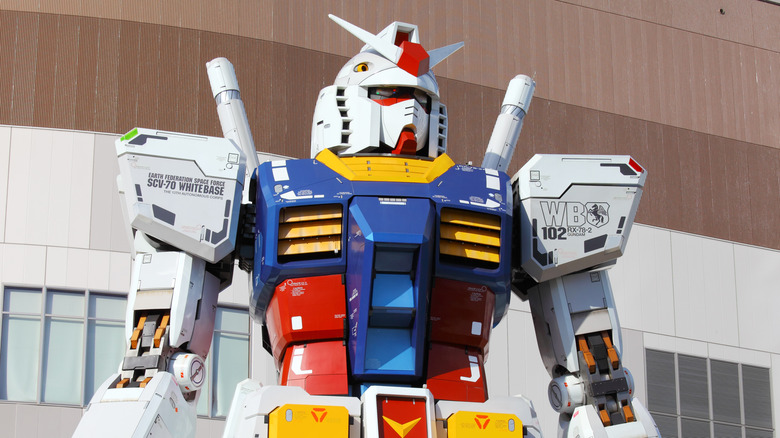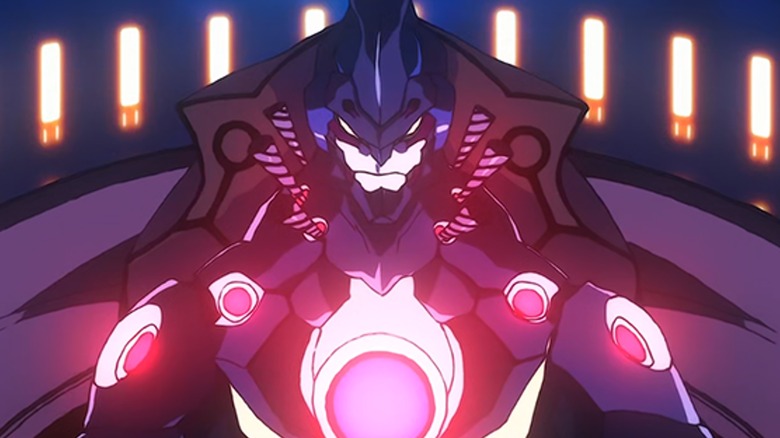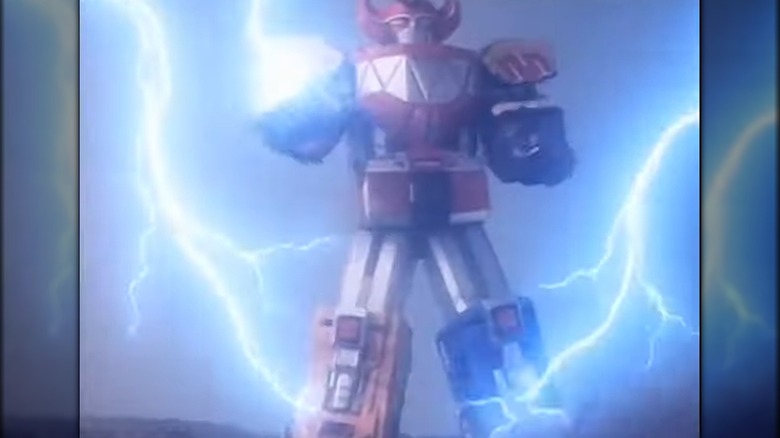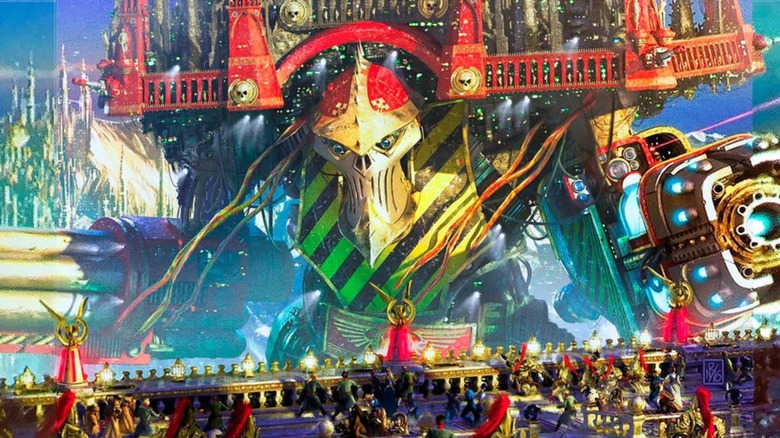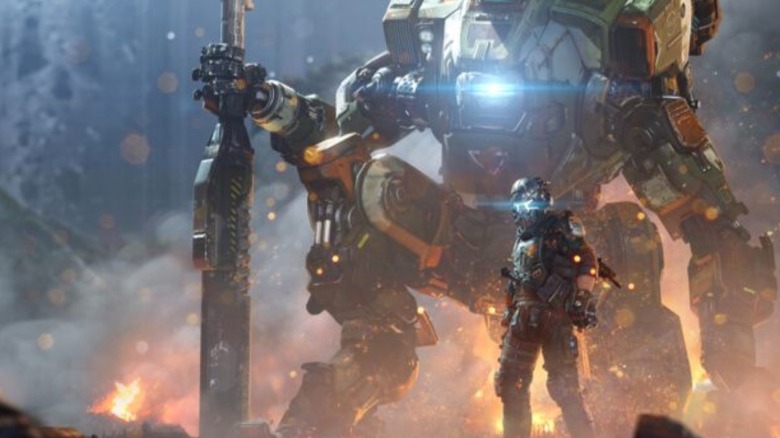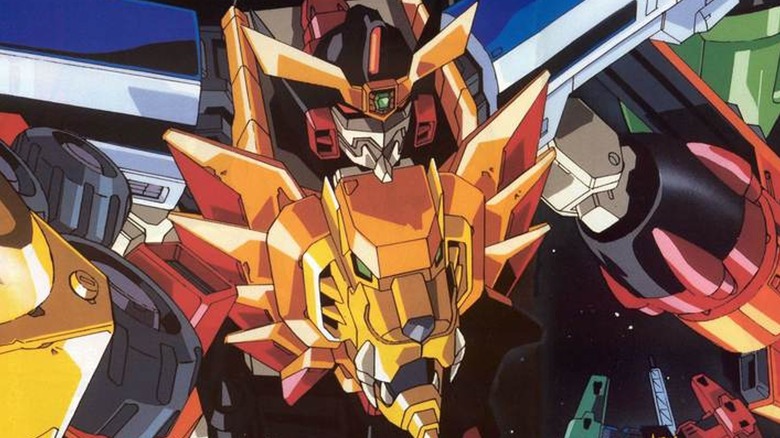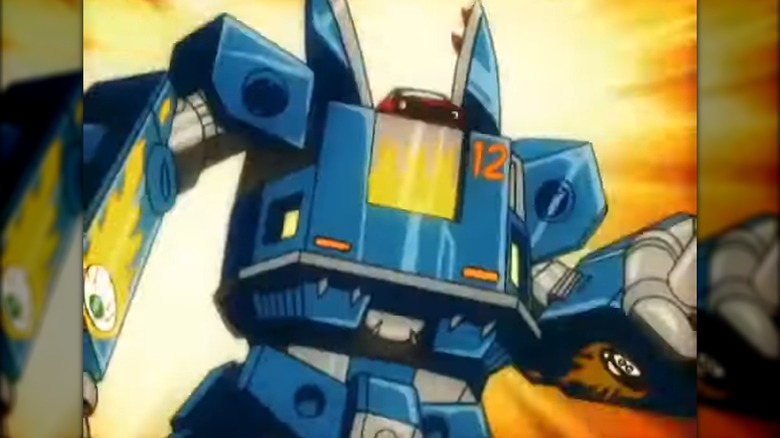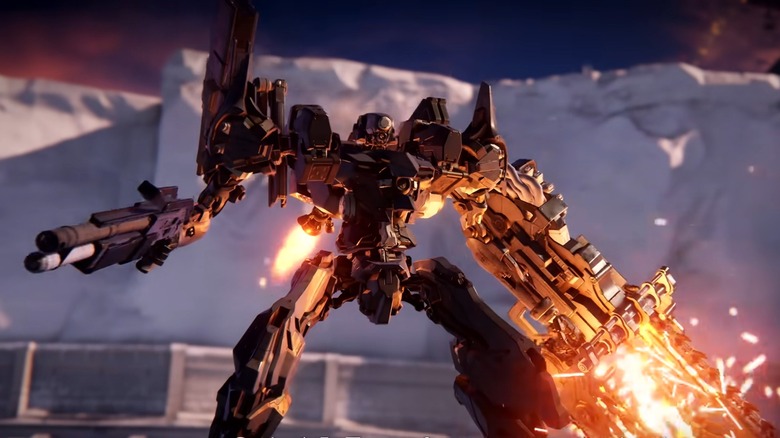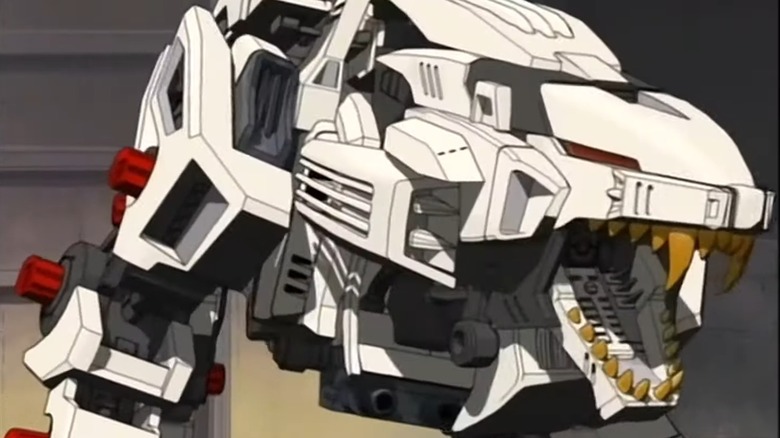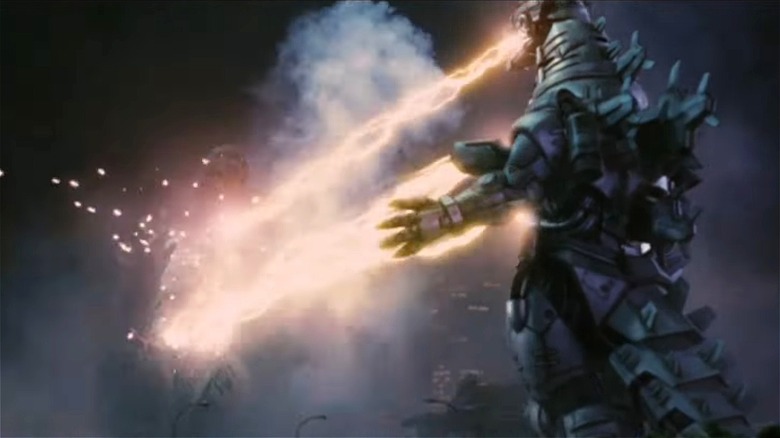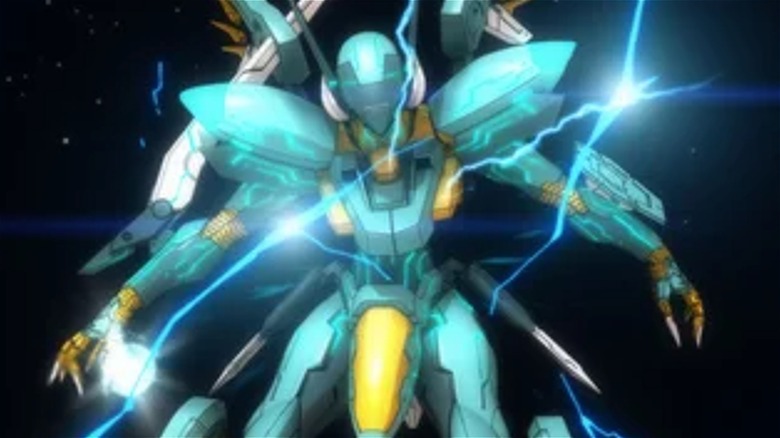10 Sci-Fi Mechs We'd Love To Test Drive
Science fiction lets audiences escape the confines of reality without going too far into the literary left field known as fantasy. Not that there's anything wrong with the fantasy genre, mind you. On a surface level, sci-fi worlds stay recognizable because they are rooted in science, but many technologies in these settings go beyond what our society is capable of. Some even transcend the laws of physics.
The term mech – sometimes mecha — is a catch-all used to describe giant pilotable robots. Depending on the level of technology in the story, sometimes mechs are little more than tanks with legs, while other times they are veritable gods of metal and circuitry. Few mechs look exactly the same, and depending on the setting and mech's design, capabilities fluctuate wildly. Essentially, there's a mech for every kind of sci-fi fan. Do you want a small, quick mech that specializes in scouting? There are plenty of those. What about a mech that's as slow as a glacier but can annihilate entire cities? We've got those too.
Not all mechs are created equal, but here are some of the coolest ones we'd love to pilot, even for just a quick ride around the block.
Lazengann
"Gurren Lagann" is arguably the craziest mecha anime ever created. The show's flagship robot, Gurren Lagann, uses drills to attack, combines with and empowers other robots, and defies physics on an hourly basis. However, as powerful as Gurren Lagann can get, its evil counterpart Lazengann is arguably cooler.
Lazengann is the antithesis of Gurren Lagann, as befitting the mech of the show's first primary antagonist. Whereas Gurren Lagann is bulky and ostentatious, Lazengann is sleek, slender, and sinister. To put it another way, Gurren Lagann looks cool because the mech works hard at it, whereas Lazengann looks cool without even trying.
While appearances play a big part in our preference for Lazengann over Gurren Lagann, the true deciding factor is the gulf between capabilities. Technically speaking, both mechs have the same skill sets, but Lazengann edges Gurren Lagann out in speed, durability, and style. Both can sprout drills all over their bodies, and Gurren Lagann combines them into one great big giga drill, which — mind you — is still awesome.
Lazengann, however, wins because it uses these like whips. Ergo, Lazengann channels the show's spirit of prioritizing human willpower and bullheadedness over logic and physics even more than Gurren Lagann. So yes, using a drill like a drill is awesome, but using a drill like a lathe is even more awesome, especially when it is accompanied by one of the best songs in the show.
The Megazord
The "Mighty Morphin' Power Rangers" helped get an entire generation of U.S. children addicted to superheroes in color-coordinated spandex costumes piloting giant robots. Since "Power Rangers" has been running for 30 years, the franchise is full of awesome robots, but if we had to pick one, it would be the mech that started it all.
The original Megazord – or DaiZyuJin to "Super Sentai" purists — is the OG combining mecha for most Western audiences. Five color-coordinated robots based on ancient beasts combine to form a mobile tank that can shift into an iconic humanoid form. The Megazord embodies aesthetic simplicity. While the Megazord has cool horns and emblazoned shoulder pauldrons, the individual robots disappear into the larger humanoid form. If it weren't for the blue and yellow triceratops and sabertooth tiger boots, one could easily assume the Megazord was one robot instead of five.
While many mechs emphasize firepower, the Megazord channels the sword-and-board archetype. When it isn't stomping across arenas to punch giant monsters in the face, the Megazord is stomping towards them with a sword and shield. Due to its weight and chunky design, the Megazord hits a cathartic middle ground between slow and speedy, which makes it a joy to watch. When the going gets tough, the Megazord can combine with two more giant robots to form the Ultrazord, which sports plenty of firepower despite wearing a hat formed out of a bifurcated dragon robot.
Admittedly, the Megazord has one fatal flaw — you need four friends to pilot it. Of course, friends who pilot awesome mechs together stay together.
Imperator-class Titan
The "Warhammer 40,000" franchise thrives on larger-than-life characters and technologies. For instance, the mascots are eight-foot-tall supersoldiers who wield guns that fire self-propelled bullets the size of anti-aircraft rounds that drill into their targets and then explode. While most "Warhammer 40,000" ground combat consists of infantry and armored vehicles, it's not uncommon for mechs to enter the fray, and they are every bit as ostentatious as the rest of the franchise.
In the "Warhammer 40,000" universe, almost nothing compares to the might of an Imperator-class Titan, alternatively known as an Emperor Battle Titan. These imposing mechs stand almost 200 feet tall –- although some sources peg them closer to 150 feet – and are weighed down with virtually every giant weapon known to the Imperium of Man. We're talking about a gargantuan Gatling gun on one arm and a plasma thrower on another, six back-mounted weapons that can include missile launchers, laser cannons, and shield generators. Oh, and each Imperator carries heavily fortified cathedrals on their backs.
While Imperator-class Titans have all the speed of continental drift, they make up for it in overwhelming firepower. Just point one in any direction, and you can guarantee every invading alien and daemon-worshiping cultist in front of it will be annihilated, either blown to bits or crushed underfoot. The cathedral humpback isn't just for show, either, as each can house a company worth of soldiers to lay down covering fire and defend against boarding parties. When you need to rain down vengeance on your enemies, Imperator-class Titans are the strongest you can get short of total planetary annihilation.
Titan BT-7274
Typically, a mech has all the autonomy of a real-world tank: No pilot, no movement. Some mechs coexist with AI-fueled robots within their respective worlds, but the melding of giant combat frames with artificial intelligence is relatively rare. So when a giant robot is not only capable of autonomous movement but has a well-written personality, we just have to get in the cockpit.
In the world of "Titanfall," giant mechs called Titans straddle the line between speedy and lumbering while appearing in a variety of chassis that denote different battlefield roles. However, they all pale in comparison to BT-7274. At first, BT seems like your average Vanguard-class Titan — which is the basis for the Monarch chassis in multiplayer — but over the course of "Titanfall 2," BT demonstrates its true capabilities by equipping weapons and add-ons normally exclusive to other Titans.
Technically, BT-7274 is the designation of the AI powering the Vanguard-class Titan that players command, not the Titan itself. Throughout the game, BT demonstrates it is not only capable of autonomous action and decision-making but also smarter than the average Titan. Better yet, BT sets itself apart by being a genuinely likable digital entity with a personality and character arc. Also, BT has the ability to be installed into another Vanguard chassis if its current one is damaged beyond repair. The only thing better than a 24-foot tall, 40-ton best friend is one that's also functionally immortal.
GaoGaiGar
What's cooler than piloting a giant robot? Giant robots (or vehicles) that combine to form an even bigger robot. This trope has been a proud mecha tradition ever since Ken Ishikawa and Go Nagai created "Getter Robo," and it is the cornerstone of Bandai Namco Filmworks' "Brave" series. While this company made plenty of great combining robots, there is only one King of the Braves.
GaoGaiGar is the final conglomerate form of three smaller vehicles -– a drill tank, a bullet train, and a stealth jet –- and a lion robot that can transform into a humanoid form. The result is an imposing and towering sight, but one built for justice and powered by alien technology. Thanks to its extraterrestrial power source, GaoGaiGar is capable of performing attacks and wielding weapons that defy the laws of physics.
In true "Brave" series fashion, GaoGaiGar has plenty of tools that can be sold as toys as well as save the day. You've got a bumbling, boisterous robot that transforms into a giant hand and squeaky hammer, a giant screwdriver that folds space around it to create battle arenas, and four smaller giant robots that combine into GaoGaiGar's true final form. These might seem like overkill, but GaoGaiGar was built to combat invading aliens that transform mundane vehicles into giant robots impervious to most weapons. Unless you rip out their cores with GaoGaiGar's signature attack, they'll just keep rampaging.
Unfortunately, you need to be a super-strong cyborg to pilot GaoGaiGar because it stresses the body so much, but that's a small price to pay since piloting GaoGaiGar is accompanied by an awesome theme song.
Megas XLR
The vast majority of giant mechs originate from Japan. This wing of mecha media is responsible for countless tropes, from combining robots to the tradition of launching countless missiles en masse. When the U.S. does mechs, these fall into one of two categories: smaller, more grounded vehicles such as those in "Battletech" and playful parodies of Japanese mechs.
The Megas XLR (a combination of the acronyms Mechanized Earth Guard Attack System and eXtra Large Robot) is a hot rod of mech tropes. Originally a prototype war machine designed by (and stolen from) an invasive alien species, the Megas was customized with countless weapon systems and a metal paint job. However, its head has been replaced by a classy Plymouth Barracuda, and its controls were completely reworked into the most unorthodox and awesome setup imaginable — a collection of video game controllers, including motion controls.
Since it was originally crafted by warmongering extraterrestrials, the Megas XLR has more weapons than could plausibly fit inside its chassis, each more destructive than the last. Many of these weapons reference signature attacks from Japanese mech shows, yet none weigh the giant robot down in the slightest. Even though it boasts enough firepower to level a city, the Megas is still agile enough to pull off every pro wrestling move in the book and wipe the floor with anything that challenges it.
The Megas XLR is a mecha designed to be as cool as possible and appeal to fans of anime, hot rods, guns, heavy metal music, and the WWE. It's as the theme song implies: Everyone digs giant robots.
Armored Core
Like most real-world weaponized vehicles, mechs are primarily designed for one battlefield role per model. While many mechs can be customized with a variety of weapons, these payloads are usually limited depending on a mech's specialization. However, one mech, or to be specific, one series of mechs, stands out for its ability to adapt to any situation.
The titular Armored Cores (ACs for short) of the "Armored Core" franchise are a line of mechs that are built upon modularity. Each AC has a Core that houses the engine, cockpit, and connection points, but aside from that, no two ACs are alike. Sort of. Technically speaking, ACs rely on standardized parts that pilots can mix and match mostly as they see fit. Granted, some combinations are more effective than others, and you always have to take weight and energy consumption into consideration, but that's easy to do with enough experience.
When starting out, AC pilots are limited, but with the right items, they can produce tanky energy weapon specialists, speedy mechs that focus on rushing enemies with melee strikes, and flying quad-legged missile spammers. Once you're flush with parts and cash, the sky's the limit. One can create mechs that hover indefinitely, smash through defenses, or not worry about reloading weapons. You gotta love mechs that let your imaginations run wild.
Liger Zero
Most giant mechs mirror the human form. Even more unconventional designs with reverse-jointed knees and digitigrade legs (legs that put pressure on the toes of the foot instead of the soles when walking) are still generally humanoid. But every now and then you see a mech that takes inspiration from the animal kingdom without sacrificing any of the wow factor. Or the firepower.
Unlike many other giant mech series, "Zoids" began as a series of model kits and ended up inspiring several anime shows. While the Zoids come in many animalistic forms, the most famous and arguably coolest is the Liger Zero. True to its name, this mech takes the shape of a cat, somewhere between a lion and a tiger. Also, it sports a simple yet striking monochromatic color scheme with white armor plates, black underframe, and yellow claws. The "Zoids" series has several other Liger models, but they just don't have the presence or the jet boosters of the Liger Zero.
In its base form, the Liger Zero is an agile mech capable of intense bursts of speed, and its claws can cut through almost anything. However, the Liger's true colors come to the surface thanks to a series of color-coded armor sets -– it is based on a model kit, after all. Depending on the armor, the Liger can shift into a long-range support railgun, a rocket-powered robot, or a four-legged lightsaber. The only downside to the Liger Zero is that it's semi-sentient and refuses to be piloted by just anyone, but when it behaves, it's a ride any mech junkie would adore.
Kiryu
Contrary to popular belief, the EVA Units in "Neon Genesis Evangelion" aren't giant robots but living humanoid beings encased in armor. This means they aren't mechs and are thus ineligible for this list. However, a giant robot that uses the bones of a radioactive lizard as its literal skeleton is fair game, especially when it's capable of fighting the King of the Monsters to a standstill.
Kiryu, also known as Millennium Mechagodzilla or Multi-Purpose Fighting System 3 (MFS-3 for short), is arguably the most important piece of lore in the "Godzilla" franchise. It's also the most spectacular. For starters, the mecha is a metal doppelganger of Godzilla. However, unlike prior and subsequent Mechagodzillas, Kiryu does not lack weapons. This mecha has shoulder-mounted missile pods, wrist-mounted railguns, and the Absolute Zero Cannon, which is a chest beam that flash freezes its targets to absolute zero. This weapon is later replaced by a weaker -– but more fuel-efficient -– triple laser canon.
Unlike other Mechagodzillas, Kiryu isn't just a long-range artillery battery in the shape of Godzilla; it's the only manufactured mech that ever faced off against the creature. The secret to Kiryu's capabilities is its speed, drill claw, and skeleton. In fact, this mecha links the Millenium series of "Godzilla" films (stretching from 1999 to 2004) with the 1954 original film by using the bones of that movie's Godzilla as its framework.
Kiryu also boasts a techno-organic AI powered by Godzilla's DNA. This design lets pilots control Kiryu remotely, which is always a plus when fighting kaiju, but it comes with a cost — Kiryu is prone to being controlled by Godzilla's ghost.
Jehuty
Western fiction tends to depict mechs as lumbering towers of metal and machine guns. Eastern media, however, generally portrays mechs as armored titans, but armored titans that aren't weighed down by their weapons. Mechs in Japanese games and shows are often as agile as any flesh-and-blood human. Depending on the technology, they can even vastly exceed the capabilities of most vehicles.
Jehuty, from the "Zone of the Enders" video game series, belongs to a special class of mech known as an Orbital Frame. While these mechs come in a variety of shapes, they are invariably sleek, lack proper feet, and have generally humanoid forms. Oh, and their cockpits are long, pointed, and located in what would be the groin area. Yes, even on decidedly feminine Orbital Frames.
Like all Orbital Frames, Jehuty is extremely mobile and capable of dashing at blinding speeds in any direction. Unlike other Frames, Jehuty is packed to the brim with energy weapons, including a retractable arm blade, homing missiles, and a holographic decoy. However, what truly makes Jehuty worth a test run is the fictional ore that powers it — Metatron. This substance fuels a reactor that provides near-limitless energy.
Beyond that, Jehuty comes with an AI that assists its users in battle. Literally anyone – even a child – can become an expert Jehuty pilot with its assistance. In addition, we can't forget that Orbital Frames, Jehuty included, are infused with Metatron and can regenerate by absorbing the material, which cuts down on repair times, the bane of all mech users.
